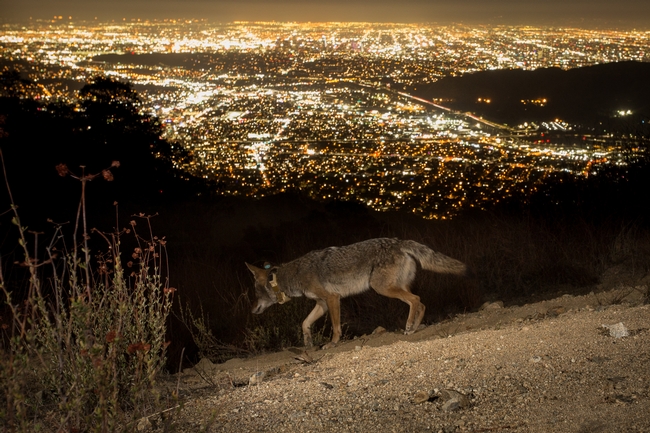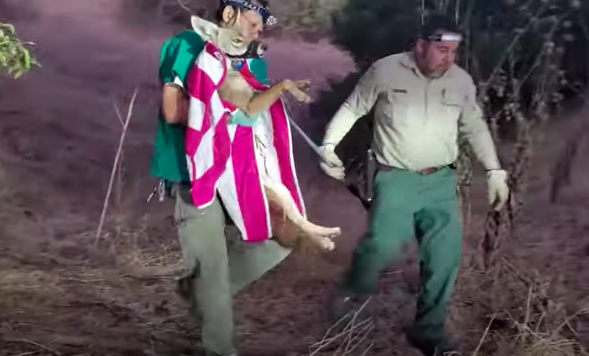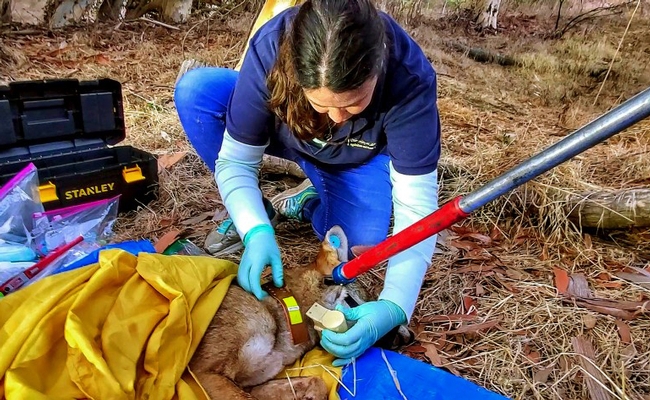Coyote conflicts with Californians are on the rise, with reports of urban coyotes biting people and killing pets. In July, two people were bitten by a coyote in separate attacks on a trail in Mission Viejo. Recently one elusive coyote has been linked by DNA tests to biting attacks on two children and three adults in the East Bay Area. To better understand coyote behavior, University of California Cooperative Extension advisor Niamh Quinn has been collaring and tracking coyotes in the Los Angeles area.
In urban areas, hazing is often used to frighten coyotes and deter them from approaching people. Although waving arms and shouting at urban coyotes are commonly thought to drive the animals away, no research has been done to determine whether hazing truly changes coyote behavior. Human and wildlife interactions expert Quinn is studying the movement of urban coyotes to find out how effective hazing is.
With funding from the Los Angeles County Quality and Productivity Commission and the Los Angeles County Agricultural Commissioner/Weights & Measures Project, Quinn bought GPS tracking collars and pays for game cameras to find the coyotes.
“Without the support of the county we wouldn't have a project,” said Quinn, who is based at the UC South Coast Research and Extension Center in Irvine.
UC Agriculture and Natural Resources and LA County Agricultural Commissioner/Weights & Measures share the goal of learning how to more effectively manage coyotes. Because so little information is available, this project is expected to help both county and municipal managers who have found themselves involved more frequently in the management of wildlife over the last decade.
A documentary by Benjamin Fargen describes Quinn's research. In “Coyote Conflict in Los Angeles - The UCANR Hazing Study,” Fernando Barrera of Los Angeles County Agricultural Commissioner/Weights & Measures says about 60 pets were taken from people's homes in a three-month period near a park in the county. LA County Agricultural Commissioner/Weights & Measures sets out humane traps that are designed specifically to catch coyotes and for quick release of other species.
“They help set and unset traps, scout for new trapping sites and are there in the middle of the night to help me handle the coyote when we trap them,” Quinn said.
Although they know where coyotes are, catching them to put collars on isn't easy. In the documentary, Quinn describes watching via game camera monitor as coyotes approach traps, but not close enough to get caught.
“We wouldn't be able to do this research without a team,” Quinn said. “For scientific research, we need different ideas to come from people with different expertise. It can be a frustrating mix of trying to get all the team together, our veterinarian Curtis Eng of Western University of Health Sciences has to be available, the trappers have to be available and I have to be available.”
Quinn monitors her phone for alerts constantly. “I'm listening for the buzz of my phone to tell me there's something there.”
To date, Quinn's team has collared 19 coyotes. One coyote she has dubbed “Lazy Legs” has a range of about a half-mile, partly in natural habitat, but often in neighborhoods. In contrast, a female collared coyote has ranged 7 to 10 miles.
“You can see that she hangs out in the natural areas, but also dips in and out of the neighborhoods,” Quinn said. “She's probably choosing to go into the neighborhoods to find maybe some trash, maybe cats, or maybe even some rats because we know they eat rats. We know they eat a lot of cats and they eat a lot of bunnies.”
After a coyote killed her cat in 2011, Debora Martin launched Coyotes of Orange County to educate pet owners how to keep their pets safe from coyotes. She praises Quinn's Coyote Cacher website https://ucanr.edu/coyotecacher for the map showing where community members have reported coyotes have been sighted. “Based on that information, things can be done,” she said.
Torrance Police Department has also partnered with Quinn to learn about wildlife management and to educate the public about coyotes. Residents may unintentionally attract coyotes by leaving pets and pet food outside or fruit that falls from trees in their yards.
“Coyote Conflict in Los Angeles - The UCANR Hazing Study” can be viewed for free on YouTube at https://www.youtube.com/watch?v=IEnqU24RgAU&feature=youtu.be. To learn more about the coyote hazing research, visit https://www.ucscurri.com/hazing and follow Cosmopolitan Coyotes on Instagram https://www.instagram.com/cosmopolitancoyotes.
UC Agriculture and Natural Resources brings the power of UC to all 58 California counties. The coyote conflict project and other UC ANR programs rely on donor contributions. To learn more about how to support human and wildlife interactions research, visit https://donate.ucanr.edu/?fund_id=1145.


